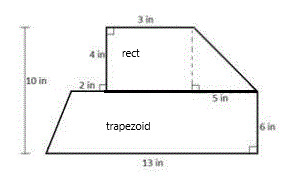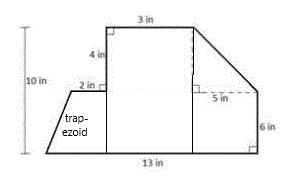| Problem |
Hint |
3) Find the area of the figure:
Method 1 (horizontal cut) diagram:

Method 2 (vertical cuts) diagram:

|
Method 1: Draw a line horizontally that is along the 5 inch side of the inscribed triangle.
That results in 3 figures: 1 rectangle, 1 triangle and 1 trapezoid on the bottom. So, here we go:
1. Compute the area of the triangle = ____ sq. in.
2. Compute the area of the rectangle on the top = ____ sq. in.
3. Write in the length of the line you drew to cut the figure = ____ in.
4. Compute the area of the trapezoid using the area formula for a trapezoid:
A = (b1 + b2) h / 2, where:
b1 = length of one base,
b2 = length of the other base, and
h = height of the trapezoid.
A = _____ sq. in.
5. Add these to get the total area of the figure = _____ sq. in.
Method 2: Draw vertical lines that cut the figure into 2 rectangles, a trapezoid and a triangle:
1. Compute the area of the triangle = ____ sq. in.
2. Compute the area of the big middle rectangle = ____ sq. in.
3. Compute the area of the small rectangle = ____ sq. in.
4. Write in the length of the base of the trapezoid = ____ in.
5. Compute the area of the trapezoid using the area formula for a trapezoid:
A = (b1 + b2) h / 2, where:
b1 = length of top base,
b2 = length of the other base, and
h = height of the trapezoid.
A = _____ sq. in.
6. Add these to get the total area of the figure = _____ sq. in.
|
4) The point (5,-3) is reflected across the x-axis, moved left 2 units and then reflected across the y-
axis. What are the coordinates of the new point?
|
Use the grid on problem 2 to plot these points.
1. To "reflect across the x-axis" means to change the sign of its Y coordinate. That point (reflected) is (___,___)
2. Now move it left 2 units (subtract 2 from the X coordinate) = (___,___)
3. To "reflect across the y-axis" means to change the sign of the new point's X coordinate. That new point
(now reflected twice) is (___,___)
|
|